By Iain Clark: James Bacon at Journey Planet approached me with an interesting proposition: would I be interested in painting a new version of a Dave Gibbons Watchmen cover, for an issue of the fanzine dedicated to the comic, but with a twist?
This was a challenge, and to be honest, it wasn’t an automatic yes.
I’ve done a few covers for Journey Planet (issues 65, 69 and 74), not to mention several pieces for the Glasgow 2024 Worldcon including the BSFA award-winning “Shipbuilding Over the Clyde” (2020) and “Glasgow Green Woman” (2021). But these were my own compositions, and I have no experience as a copyist. Also Dave Gibbons is a world-renowned genius. I, charitably, am not.
The cover was one of James’ favorites, the colors and contrast being to his liking and it was used for the Watchmen Portfolio, a huge 15.5” x 10” portfolio containing the French and US comic covers and the advertisements promoting that comic, produced in 1988.
Fortunately the cover is a clean graphic design with no figures in it. I’m pretty good at replicating a reference photo when doing fan art, and this seemed achievable so I cautiously said yes, thus launching my career as an international art forger.
The original Dave Gibbons art
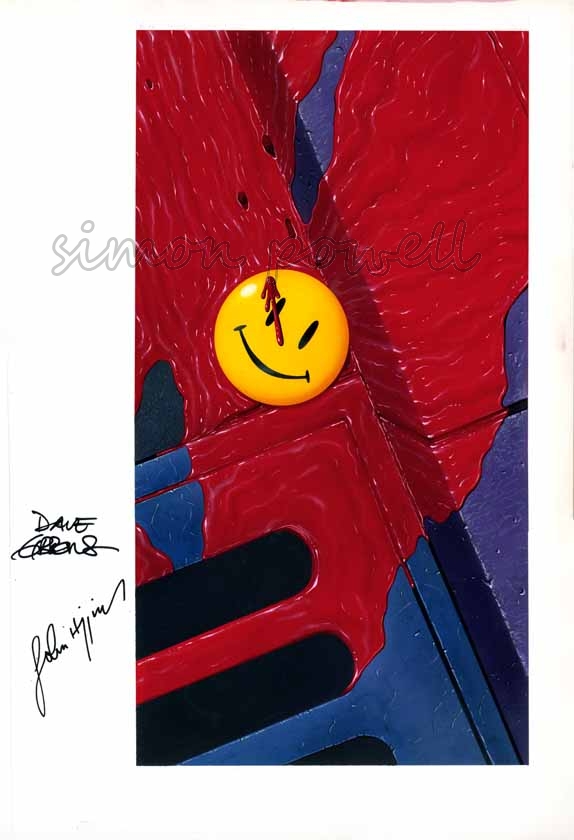
The ingenious twist for the Journey Planet version, suggested by Pádraig Ó Méalóid, was to have the famous smiley yellow badge upside down for use on the back cover (with the original art as the front cover); the idea being to imagine an alternate universe in which the badge fell, unnoticed, face down in the gutter and the whole sequence of events presented in the comics unraveled.
To complicate matters I was then asked if the final painting could still have the badge face up. As the face of the badge is very smooth, overpainting the smiley face over the reverse of the badge seemed impractical so I chose to start by creating as exact a copy of the original as I could manage, and then do the back of the badge separately to be added digitally.
The color balance of the various reference sources varied considerably. I went with what seemed a good balance of the sources that drew out the subtle color differences in parts of the image (for example the purplish kerb and the slightly bluer drain). Then it was a case of gridding-up the image, transferring it with pencils to stretched 250 gsm paper on a board, and getting to work.
That’s when the fun began.
I don’t know what scale or medium Dave Gibbons used for the original but as I’m primarily an acrylic painter that’s what I chose. I began by blocking in base areas of color onto my pencils
My copy at an early stage, with a print-out of the original art clipped to one side.
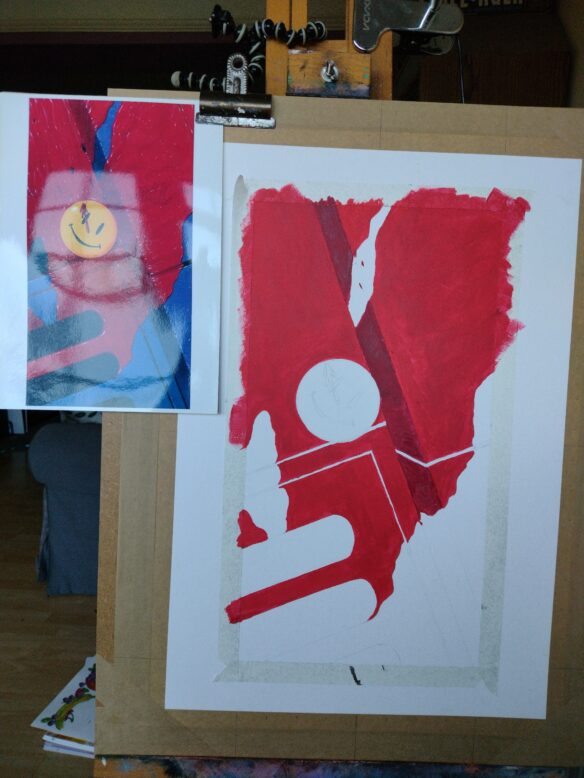
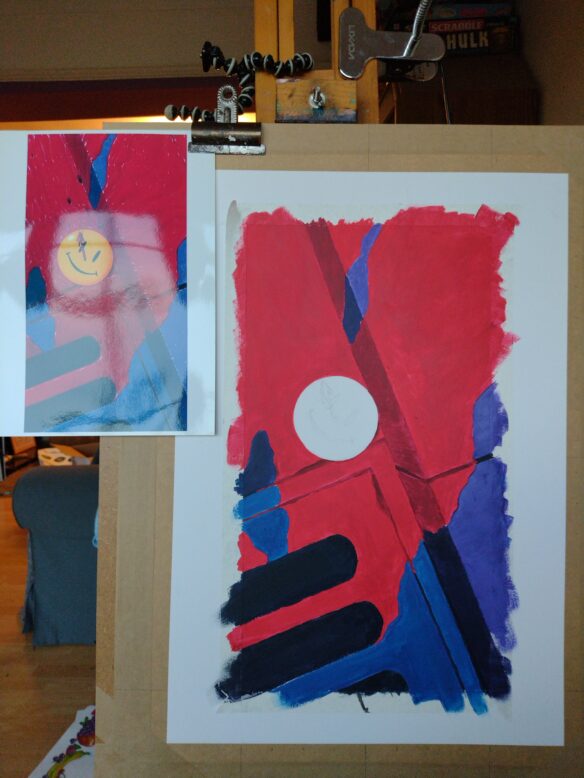
Once I had the color blocked in I started adding the texture and shade. The more I worked the more it became clear that copying someone else’s art style is uniquely challenging. Dave Gibbons had skillfully rendered the flowing blood in a distinctive, stylized way with detailed patterns of light and shade in the rivulets, and glints of light in specific places. His image is no doubt a product of his experience, skill and countless spontaneous choices as he worked. Rendering the blood in my own style would have been relatively straightforward. Matching another artist’s tiny creative decisions was much harder, and a long way from intuitive. The reference images also varied considerably in the level of contrast which greatly affects how visible the blood textures and highlights become.
Acrylics are not the easiest medium to blend smoothly (my fault for choosing them!), so I used a slow drying medium, using several layers and some scumbling with the brush. It took a lot of rework to create subtly blended acrylics which closely (but by no means exactly) mirrored the original. Fortunately Mr. Gibbons’ style doesn’t show brush marks so there was no need to replicate that degree of spontaneity, but it was still a case of very carefully matching something that was originally far more natural. The process was instructive, and I certainly gained a new appreciation for the incredible detail and mastery in the original art.
I kept adjusting as I went to match the shapes and textures of the original as closely as I could, for example adding a thin wash of scarlet ink at a fairly late stage to give the blood more lustre and saturation. Again this is very much a judgement call as my reference images of the original varied from bright scarlet to deep magenta.
My copy nearing completion
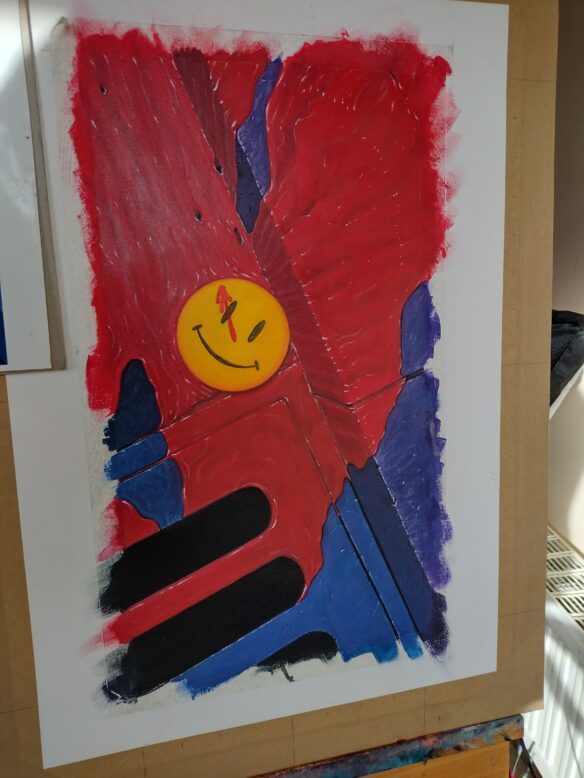
The badge was its own challenge. I nearly had a disaster when I tried to clean up a stray mark and ripped off a coin-sized chunk of the surface of the paper, right on the smoothest and least forgiving part of the image where there was no chance of adding texture to conceal the problem. After a brief trip to the black abyss of despair and a short flirtation with the idea of throwing the painting out of the window I decided to try a very fine grade sandpaper and rich white gesso to rescue the painting and bring the surface of the badge back to smooth. If I’d torn right through the paper you probably wouldn’t be reading this article.
Once I was happy with the painting I added a little “CLARK AFTER GIBBONS” to the bottom to keep me out of art prison, thus ending my career as an international art forger.
Finally I moved onto the back of the badge, which I did to the same scale as the rest of the image. Pádraig was able to supply photos of the back of his original badges from 1986 which was immeasurably helpful. The direction of the pin was to match the “clock hand” blood splatter on the original so I made sure that the light direction matched the rest of the image, and that the tone of the yellow edging matched the front. This was easily the most straightforward part of the project as I was free to make my own art choices. I added one blob of Gibbons-style blood to integrate it with the rest of the image.
The back of the badge

I used Photoshop to add my reversed badge to my full painting, and did a bit of color correction to match the reference.
The final composited image.
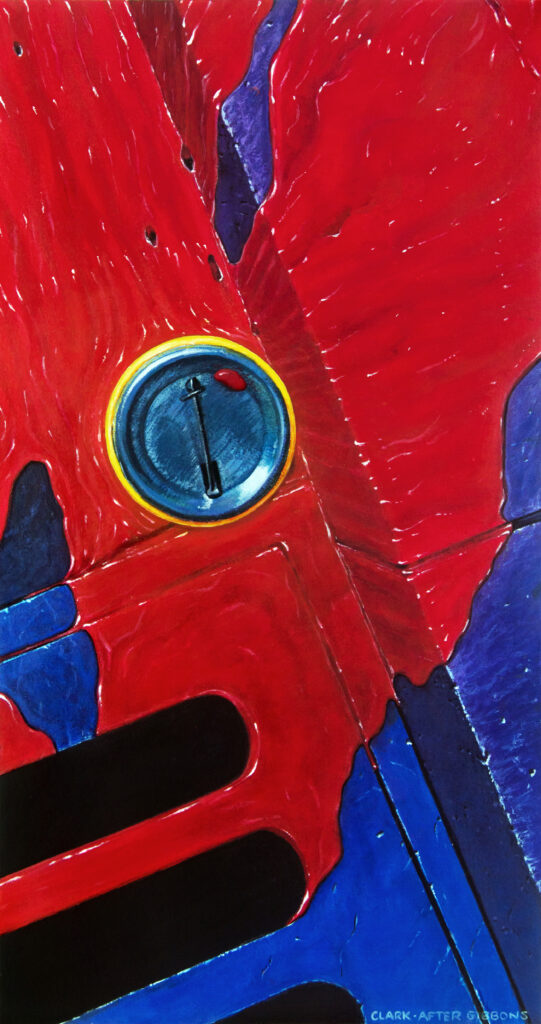
All told this painting took me a couple of weeks around my day job. It was much more time consuming than I imagined at the outset because of the unexpected demands of matching another artist’s creative choices, but I’m quite pleased with how it turned out.
James and the Journey Planet team were delighted with the image, and so impressed and enthusiastic as James can be, that they asked to use the images for both the front and back covers. Michael Carroll worked up the sidebar logos in keeping with the original individual issues of Watchmen. The version with the upside-down badge went on the front cover with a yellow logo, and the image with the face-up badge went on the back with a green logo.
Ninety two pages of work from a variety of writers, fan and professional alike – with some fascinating insights – were sandwiched between these pieces when the team Jpresented the Fanzine to the world.
James then asked me if I would share my experience here on File 770. I’m very pleased with how the cover turned out. This was a different kind of undertaking for me but that made it an enjoyable challenge in its own way, one that it stretched me as an artist in unexpected directions by forcing me to realize a specific effect. I have very vivid memories of reading Watchmen when it was first collected (my elderly copy is the British yellow cover from 1987, 3rd printing). Even back then it had a considerable reputation and I gave it the close attention of a hallowed text. I’m happy to have contributed my own little tribute with this cover and grateful to Journey Planet for thinking of me!
Discover more from File 770
Subscribe to get the latest posts to your email.

You have no idea how much I absolutely adore both the front and back covers!
Chris
Thanks, both for the painting itself and for an interesting explanation of the process that produced it.
Wonderful art (and explanation thereof).
I love both the art and the story. Thanks.